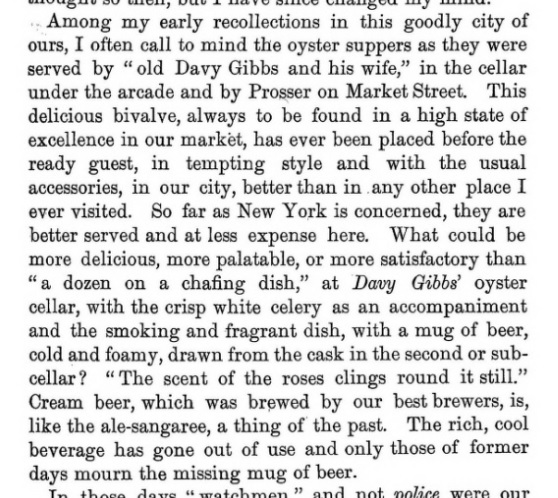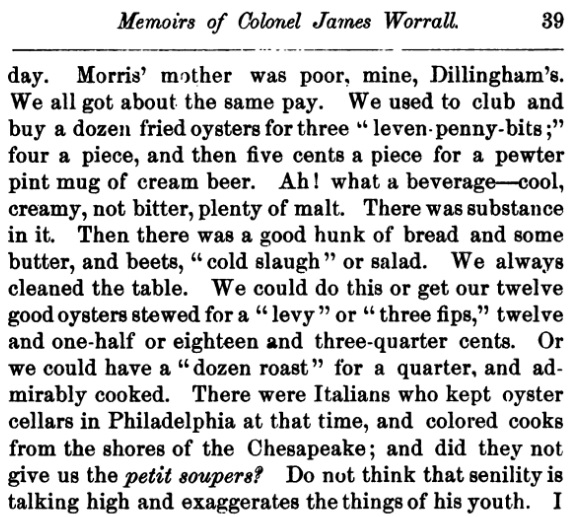
…by “handsome” I presume you mean the “other” one…
Here’s the thing. There is only so much I can lay out to support this idea so I might as well do it and admit that it is something of a reasonable hypothesis. To be fair, I rarely take a position that I can’t later extract myself from. I am squidly like that. But today I am almost extracting myself at the same time I make the assertion. Which assertion? That cream beer in 1820 may well be the forefather of cream beer today and that neither has anything to do directly with cream ale. Three people worldwide just fell off their chairs. How did I get there? First, I submit two biographical statements for two people – John and Mary – who were each children of German-American immigrant brewers, Philip German and Christian Frederick Haas:
…GERMAN, John W., was born in Harrisburg, October 27, 1851. He is the son of Emanuel S. German, who was born in Harrisburg in 1821, whose father, Philip German, a native of Germany, came to Harrisburg in 1800, and established a brewery, celebrated for its “Cream Beer,” and conducted it for many years…
…Mrs. Maltzberger was born in Zanesville, Ohio, where her father had removed in 1833. He was a native of Germany and emigrated to America early in the nineteenth century, being a brewmaster by trade, brewing what was known in the early days as cream beer. While in Zanesville he purchased much valuable real estate, and owned a brewery, and hotel. He was a very prominent man, and was highly esteemed by all who knew him…
If you go to page 1219 of this text you will see that Mrs. Maltzberger was named Mary and her father was Christian Frederick Haas. Both Haas Sr. and German Sr. come to the young United States early in the 1800s, establish a cream beer brewery and do very well. Convinced of anything yet? Me neither. So, let’s look at this passage from the April 1900 issue of The Pennsylvania-German a magazine “devoted to the history, biography, genealogy, poetry, folk-lore and general interests of the Pennsylvania Germans and their descendants.” At page 42 in a travelogue piece, we read the following:
In Nantucket it is safe to address every man as captain, and his return salutation, if he wishes you to enter his home, is “Come aboard.” So we say. “get aboard,” and let us resume our journey westward toward Middletown, so named because it was midway between Carlisle, then an outpost, and Lancaster. Leaving the centre square, we cross the Conoy Creek, which empties into the river at Bainbridge, and gives its name to one of the townships. That old brick house, just across the bridge, used to be Pfaff’s brewery, where cream beer, or Lauderschaum, was brewed more than half a century ago. It was a pure malt, wholesome and non-intoxicating. The art of making is lost, for you see none on the market.
OK, so again cream beer is placed in the early 1800s in a German immigrant context. It also now has a German name, Lauderschaum. I am advised that schaum is German for foam. Based in part on this incredibly detailed essay on the word lauter I am going to suggest that the lauder- in lauderschaum in fact lauter- and means “pure” or “honest” or even “only” which makes cream beer pure honest foamy beer. Buying anything yet? OK, how about this. It is a memoir of a gent, George Farquhar Jones, who lived from 1811-1887 in both Providence, Rhode Island, and Philadelphia and contains this recollection at page 231:

Rich, cool, in Pennsylvania and no longer in existence when the book was published in 1887. Hmm… Another? OK, look at this:
It’s another passage from a second memoir – this one about one Colonel James Worrall, Civil Engineer. He lived from 1812 to 1885 and in that passage above was recalling his youth in Philadelphia. Cream beer was “cool, creamy, not bitter, plenty of malt.” Sounds familiar?
All five sources use the term “cream beer” in relation to Pennsylvania in the early 1800s. Two reference that it’s malty and not bitter. It’s lower in strength. If we go back and look at the notes on Perot’s brewing logs for 1821-22 we see that the draught beer they are brewing is lower in hops and likely lower in strength. Both these records and 1820s notices from New York City indicate that it was considered rich. I am going to declare that it was a thing based on the above. Here’s another thing. Kevin Gibson in his 2014 book Louisville Beer: Derby City History on Draft states that the City had cream beer which became known as Kentucky Common later in the century after it evolves locally to be made with corn and caramel for colouring. It was associated with German breweries, was light in alcohol and lacked bitterness. Remember Mrs. Maltzberger up there? Her father immigrated internally too, bringing his brewing and maybe his cream beer to Zanesville, Ohio, too, where he established the American House Brewery. Like the German brewer in Harrisburg, Pennsylvania around 1800 and the ones in Louisville, Kentucky, a bit later in the 1830s Christian Frederick Haas struck out for the interior to set up shop.
Which is interesting and, if correct, sets cream ale a bit adrift on its own course. If we recall, cream ale shows up in newspaper notices in the Hudson Valley in the 1830s. John Taylor of Albany takes it on and, by 1839, is selling an imperial cream ale. Taylor is a hugely successful ale brewer which is no way dependent on the German tradition. The sign proclaiming “Taylor’s Cream Ale” scars Albany’s waterfront skyline as early as 1841. His beers, like most others in the city, appear to be a different thing – big Anglo-American ale bombs – certainly when compared to lighter Teutonic cream beer awaiting its co-national lager to show up care of George Gillig in the early 1840s. Each goes on and traces its own route west – and even north as we see above – as part of the American story, evolving and lasting well into the ensuing decades and centuries.
Could it be that each happily just latch on to the adjective oblivious of the existence of the other? Could be. Could be.

